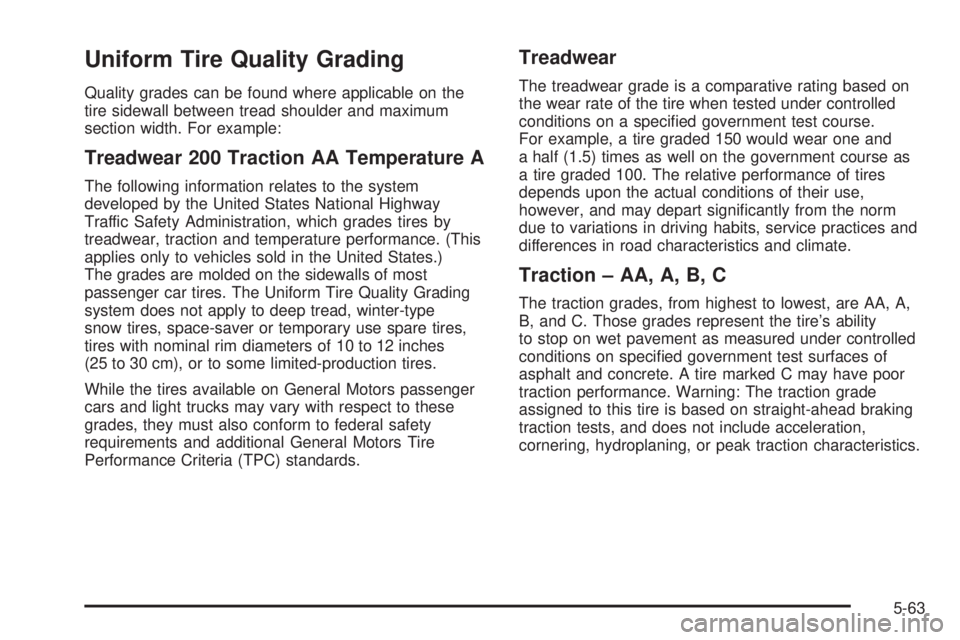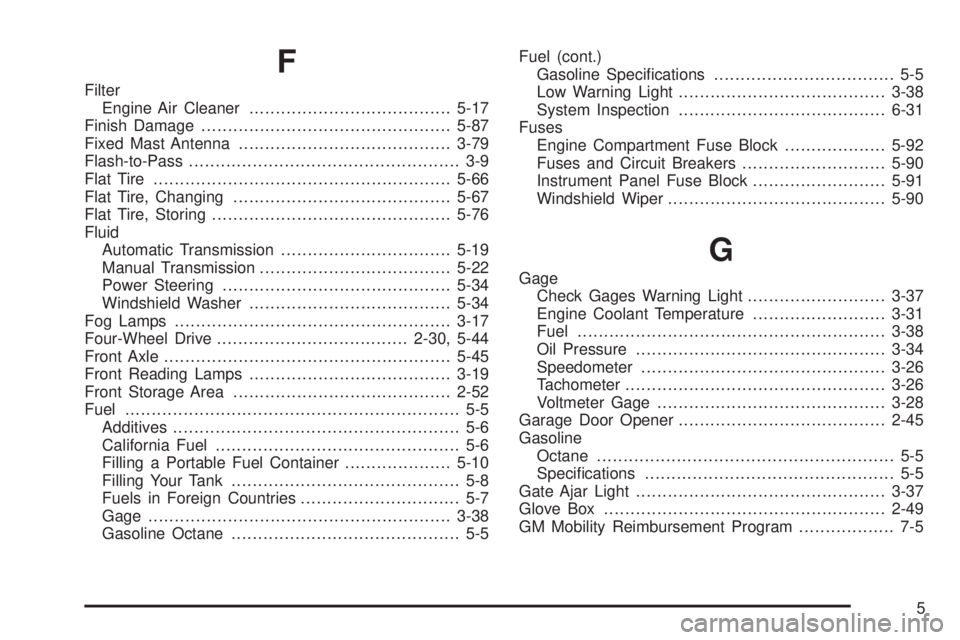warning GMC JIMMY 2005 Owner's Guide
[x] Cancel search | Manufacturer: GMC, Model Year: 2005, Model line: JIMMY, Model: GMC JIMMY 2005Pages: 432, PDF Size: 2.65 MB
Page 335 of 432

Uniform Tire Quality Grading
Quality grades can be found where applicable on the
tire sidewall between tread shoulder and maximum
section width. For example:
Treadwear 200 Traction AA Temperature A
The following information relates to the system
developed by the United States National Highway
Traffic Safety Administration, which grades tires by
treadwear, traction and temperature performance. (This
applies only to vehicles sold in the United States.)
The grades are molded on the sidewalls of most
passenger car tires. The Uniform Tire Quality Grading
system does not apply to deep tread, winter-type
snow tires, space-saver or temporary use spare tires,
tires with nominal rim diameters of 10 to 12 inches
(25 to 30 cm), or to some limited-production tires.
While the tires available on General Motors passenger
cars and light trucks may vary with respect to these
grades, they must also conform to federal safety
requirements and additional General Motors Tire
Performance Criteria (TPC) standards.
Treadwear
The treadwear grade is a comparative rating based on
the wear rate of the tire when tested under controlled
conditions on a speci�ed government test course.
For example, a tire graded 150 would wear one and
a half (1.5) times as well on the government course as
a tire graded 100. The relative performance of tires
depends upon the actual conditions of their use,
however, and may depart signi�cantly from the norm
due to variations in driving habits, service practices and
differences in road characteristics and climate.
Traction – AA, A, B, C
The traction grades, from highest to lowest, are AA, A,
B, and C. Those grades represent the tire’s ability
to stop on wet pavement as measured under controlled
conditions on speci�ed government test surfaces of
asphalt and concrete. A tire marked C may have poor
traction performance. Warning: The traction grade
assigned to this tire is based on straight-ahead braking
traction tests, and does not include acceleration,
cornering, hydroplaning, or peak traction characteristics.
5-63
Page 336 of 432

Temperature – A, B, C
The temperature grades are A (the highest), B, and C,
representing the tire’s resistance to the generation
of heat and its ability to dissipate heat when tested
under controlled conditions on a speci�ed indoor
laboratory test wheel. Sustained high temperature can
cause the material of the tire to degenerate and
reduce tire life, and excessive temperature can lead to
sudden tire failure. The grade C corresponds to a
level of performance which all passenger car tires must
meet under the Federal Motor Vehicle Safety Standard
No. 109. Grades B and A represent higher levels of
performance on the laboratory test wheel than the
minimum required by law.
Warning: The temperature grade for this tire is
established for a tire that is properly in�ated and not
overloaded. Excessive speed, underin�ation, or
excessive loading, either separately or in combination,
can cause heat buildup and possible tire failure.
Wheel Alignment and Tire Balance
The wheels on your vehicle were aligned and balanced
carefully at the factory to give you the longest tire life
and best overall performance.
If you notice unusual tire wear or your vehicle pulling
one way or the other, the alignment may need to be reset.
If you notice your vehicle vibrating when driving on a
smooth road, your wheels may need to be rebalanced.
Wheel Replacement
Replace any wheel that is bent, cracked or badly rusted
or corroded. If wheel nuts keep coming loose, the
wheel, wheel bolts and wheel nuts should be replaced.
If the wheel leaks air, replace it (except some
aluminum wheels, which can sometimes be repaired).
See your dealer if any of these conditions exist.
Your dealer will know the kind of wheel you need.
Each new wheel should have the same load-carrying
capacity, diameter, width, offset and be mounted
the same way as the one it replaces.
If you need to replace any of your wheels, wheel bolts or
wheel nuts, replace them only with new GM original
equipment parts. This way, you will be sure to have the
right wheel, wheel bolts and wheel nuts for your vehicle.
5-64
Page 339 of 432

{CAUTION:
Lifting a vehicle and getting under it to do
maintenance or repairs is dangerous without
the appropriate safety equipment and training.
The jack provided with your vehicle is
designed only for changing a �at tire. If it is
used for anything else, you or others could be
badly injured or killed if the vehicle slips off
the jack. Use the jack provided with your
vehicle only for changing a �at tire.
If a tire goes �at, the next part shows how to use your
jacking equipment to change a �at tire safely.
Changing a Flat Tire
If a tire goes �at, avoid further tire and wheel damage
by driving slowly to a level place. Turn on your
hazard warning �ashers.
{CAUTION:
Changing a tire can be dangerous. The vehicle
can slip off the jack and roll over or fall on you
or other people. You and they could be badly
injured or even killed. Find a level place to
change your tire. To help prevent the vehicle
from moving:
1. Set the parking brake �rmly.
2. Put an automatic transmission shift lever in
PARK (P), or shift a manual transmission to
FIRST (1) or REVERSE (R).
3. Turn off the engine and do not restart while
the vehicle is raised.
4. Do not allow passengers to remain in the
vehicle.
Put the wheel blocks at the front and rear of the
tire farthest away from the one being changed.
That would be the tire on the other side, at the
opposite end of the vehicle.
5-67
Page 353 of 432

Appearance Care
Cleaning products can be hazardous. Some are toxic.
Other cleaning products can burst into �ames if a match
is struck near them or if they get on a hot part of the
vehicle. Some are dangerous if their fumes are inhaled
in an enclosed space. When anything from a container
is used to clean the vehicle, be sure to follow the
manufacturer’s warnings and instructions. Always open
the doors or windows of the vehicle when cleaning
the inside.
Never use these to clean the vehicle:
Gasoline
Benzene
Naphtha
Carbon Tetrachloride
Acetone
Paint Thinner
Turpentine
Lacquer Thinner
Nail Polish Remover
They can all be hazardous — some more than
others — and they can all damage the vehicle, too.Do not use any of these products unless this manual
says you can. In many uses, these will damage
the vehicle:
Alcohol
Laundry Soap
Bleach
Reducing Agents
Fabric/Carpet
Use a vacuum cleaner often to get rid of dust and loose
dirt. Wipe vinyl, leather, plastic, and painted surfaces
with a clean, damp cloth.
GM-approved cleaning products can be obtained from
your dealer.
Here are some cleaning tips:
Always read the instructions on the cleaner label.
Clean up stains as soon as you can before they set.
Carefully scrape off any excess stain.
Use a clean cloth or sponge, and change to a clean
area often. A soft brush may be used if stains are
stubborn.
To avoid forming a ring on fabric after spot cleaning,
clean the entire area immediately or it will set.
5-81
Page 419 of 432

A
About Driving Your Vehicle.................................... ii
Adding Equipment to Your Airbag-Equipped
Vehicle.......................................................1-56
Additives, Fuel................................................. 5-6
Add-On Electrical Equipment............................5-90
Air Cleaner/Filter, Engine.................................5-17
Air Conditioning..............................................3-20
Airbag
Readiness Light..........................................3-27
Airbag Sensing and Diagnostic Module (SDM)...... 7-9
Airbag System................................................1-50
Adding Equipment to Your Airbag-Equipped
Vehicle...................................................1-56
How Does an Airbag Restrain?......................1-54
Servicing Your Airbag-Equipped Vehicle..........1-56
What Makes an Airbag In�ate?......................1-54
What Will You See After an Airbag In�ates?....1-54
When Should an Airbag In�ate?....................1-53
Where Are the Airbags?...............................1-52
AM-FM Radio.................................................3-43
Antenna, Fixed Mast.......................................3-79
Anti-Lock Brake System (ABS)........................... 4-8
Anti-Lock Brake, System Warning Light..............3-30
Appearance Care............................................5-81
Aluminum Wheels........................................5-86
Care of Safety Belts....................................5-84
Chemical Paint Spotting...............................5-87
Cleaning Exterior Lamps/Lenses....................5-85Appearance Care (cont.)
Fabric/Carpet..............................................5-81
Finish Care.................................................5-85
Finish Damage............................................5-87
Glass Surfaces............................................5-84
Instrument Panel.........................................5-83
Interior Plastic Components...........................5-83
Leather......................................................5-83
Sheet Metal Damage...................................5-87
Tires..........................................................5-87
Underbody Maintenance...............................5-87
Vehicle Care/Appearance Materials................5-88
Vinyl..........................................................5-83
Washing Your Vehicle...................................5-84
Weatherstrips..............................................5-84
Windshield, Backglass, and Wiper Blades.......5-86
Wood Panels..............................................5-83
Ashtrays........................................................3-19
Audio System(s).............................................3-41
AM-FM Radio.............................................3-43
Care of Your Cassette Tape Player................3-78
Care of Your CD Player...............................3-79
Care of Your CDs........................................3-79
Fixed Mast Antenna.....................................3-79
Radio with Cassette and CD.........................3-54
Radio with CD............................................3-46
Radio with Six-Disc CD................................3-67
Setting the Time for Radios with Radio
Data Systems (RDS)................................3-42
1
Page 420 of 432

Audio System(s) (cont.)
Setting the Time for Radios without Radio
Data Systems (RDS)................................3-42
Theft-Deterrent Feature................................3-77
Understanding Radio Reception.....................3-78
Automatic Headlamp System............................3-16
Automatic Transmission
Fluid..........................................................5-19
Operation...................................................2-25
B
Battery..........................................................5-38
Run-Down Protection...................................3-19
Before Leaving on a Long Trip.........................4-34
Brake
Anti-Lock Brake System (ABS)........................ 4-8
Emergencies................................................ 4-9
Parking......................................................2-36
System Inspection.......................................6-32
System Warning Light..................................3-29
Brakes..........................................................5-35
Braking........................................................... 4-7
Braking in Emergencies..................................... 4-9
Break-In, New Vehicle.....................................2-20
Bulb Replacement...........................................5-45
Halogen Bulbs............................................5-46
Headlamps.................................................5-46
One-Piece Front Turn Signal Lamps...............5-48Bulb Replacement (cont.)
Replacement Bulbs......................................5-50
Taillamps....................................................5-50
Two-Piece Front Turn Signal Lamps...............5-49
Buying New Tires...........................................5-62
C
California Fuel.................................................. 5-6
Canadian Owners................................................ ii
Capacities and Speci�cations............................5-95
Carbon Monoxide...................2-12, 2-40, 4-38, 4-57
Care of
Safety Belts................................................5-84
Your Cassette Tape Player............................3-78
Your CD Player...........................................3-79
Your CDs ...................................................3-79
Cargo Tie Downs............................................2-55
Center Front Passenger Position, Safety Belts....1-21
Center Rear Passenger Position, Safety Belts.....1-25
Center Seat Positions, Child Restraints..............1-49
Chains, Tire...................................................5-66
Charging System Light....................................3-28
Check
Engine Light...............................................3-31
Gages Warning Light...................................3-37
Checking Things Under the Hood......................5-10
Chemical Paint Spotting...................................5-87
2
Page 423 of 432

F
Filter
Engine Air Cleaner......................................5-17
Finish Damage...............................................5-87
Fixed Mast Antenna........................................3-79
Flash-to-Pass................................................... 3-9
Flat Tire........................................................5-66
Flat Tire, Changing.........................................5-67
Flat Tire, Storing.............................................5-76
Fluid
Automatic Transmission................................5-19
Manual Transmission....................................5-22
Power Steering...........................................5-34
Windshield Washer......................................5-34
Fog Lamps....................................................3-17
Four-Wheel Drive....................................2-30, 5-44
Front Axle......................................................5-45
Front Reading Lamps......................................3-19
Front Storage Area.........................................2-52
Fuel............................................................... 5-5
Additives...................................................... 5-6
California Fuel.............................................. 5-6
Filling a Portable Fuel Container....................5-10
Filling Your Tank........................................... 5-8
Fuels in Foreign Countries.............................. 5-7
Gage.........................................................3-38
Gasoline Octane........................................... 5-5Fuel (cont.)
Gasoline Speci�cations.................................. 5-5
Low Warning Light.......................................3-38
System Inspection.......................................6-31
Fuses
Engine Compartment Fuse Block...................5-92
Fuses and Circuit Breakers...........................5-90
Instrument Panel Fuse Block.........................5-91
Windshield Wiper.........................................5-90
G
Gage
Check Gages Warning Light..........................3-37
Engine Coolant Temperature.........................3-31
Fuel..........................................................3-38
Oil Pressure...............................................3-34
Speedometer..............................................3-26
Tachometer.................................................3-26
Voltmeter Gage...........................................3-28
Garage Door Opener.......................................2-45
Gasoline
Octane........................................................ 5-5
Speci�cations............................................... 5-5
Gate Ajar Light...............................................3-37
Glove Box.....................................................2-49
GM Mobility Reimbursement Program.................. 7-5
5
Page 424 of 432

H
Hazard Warning Flashers................................... 3-6
Head Restraints............................................... 1-6
Headlamps....................................................5-46
Automatic Headlamp System.........................3-16
Bulb Replacement.......................................5-45
Daytime Running Lamps...............................3-15
Electrical System.........................................5-90
Flash-to-Pass............................................... 3-9
Halogen Bulbs............................................5-46
High/Low Beam Changer................................ 3-9
On Reminder..............................................3-15
One-Piece Front Turn Signal Lamps...............5-48
Two-Piece Front Turn Signal Lamps...............5-49
Heated Seats................................................... 1-4
Heater...........................................................3-20
Highbeam On Light.........................................3-35
Highway Hypnosis...........................................4-35
Hill and Mountain Roads..................................4-36
HomeLink
®Transmitter....................................2-45
HomeLink®Transmitter, Programming................2-46
Hood
Checking Things Under................................5-10
Release.....................................................5-11
Horn............................................................... 3-6
How to Use This Manual...................................... ii
How to Wear Safety Belts Properly...................1-13
Hydraulic Clutch.............................................5-23
I
Ignition Positions.............................................2-21
Infants and Young Children, Restraints...............1-31
In�ation -- Tire Pressure..................................5-59
Inspection
Brake System.............................................6-32
Engine Cooling System................................6-31
Exhaust System..........................................6-31
Fuel System...............................................6-31
Part C - Periodic Maintenance.......................6-31
Steering, Suspension and Front Drive
Axle Boot and Seal..................................6-31
Throttle System...........................................6-32
Transfer Case and Front Axle
(Four-Wheel Drive)...................................6-32
Instrument Panel
Brightness..................................................3-18
Cluster.......................................................3-24
Overview..................................................... 3-4
J
Jump Starting.................................................5-39
K
Keyless Entry System....................................... 2-4
Keys............................................................... 2-3
6
Page 425 of 432

L
Labelling, Tire Sidewall....................................5-54
Lamps
Battery Run-Down Protection.........................3-19
Dome........................................................3-18
Exterior......................................................3-14
Fog ...........................................................3-17
Front Reading.............................................3-19
Map ..........................................................3-19
LATCH System
Child Restraints...........................................1-42
Securing a Child Restraint Designed
for the LATCH System..............................1-44
Liftgate/Tailgate...............................................2-12
Light
Airbag Readiness........................................3-27
Anti-Lock Brake System Warning...................3-30
Brake System Warning.................................3-29
Charging System.........................................3-28
Check Gages Warning.................................3-37
Gate Ajar...................................................3-37
Highbeam On.............................................3-35
Low Fuel Warning.......................................3-38
Malfunction Indicator....................................3-31
Safety Belt Reminder...................................3-26
Security.....................................................3-35
Service Four-Wheel-Drive Warning Light.........3-36
Tow/Haul Mode...........................................3-36
Up-Shift.....................................................3-29Lighting
Entry.........................................................3-18
Exit...........................................................3-18
Lockout Protection..........................................2-11
Locks
Door........................................................... 2-8
Lockout Protection.......................................2-11
Power Door.................................................. 2-9
Programmable Automatic Door Locks............... 2-9
Rear Door Security Locks.............................2-11
Long Trip/Highway Scheduled Maintenance........6-18
Loss of Control...............................................4-13
Low Fuel Warning Light...................................3-38
Luggage Carrier..............................................2-53
Lumbar
Power Controls............................................. 1-3
M
Maintenance Schedule
At Each Fuel Fill.........................................6-26
At Least Once a Month................................6-26
At Least Once a Year..................................6-28
At Least Twice a Year..................................6-27
Brake System Inspection..............................6-32
Engine Cooling System Inspection.................6-31
Exhaust System Inspection...........................6-31
Fuel System Inspection................................6-31
How This Section is Organized....................... 6-3
7
Page 426 of 432

Maintenance Schedule (cont.)
Introduction.................................................. 6-2
Long Trip/Highway Scheduled Maintenance.....6-18
Maintenance Requirements............................. 6-2
Normal Maintenance Replacement Parts.........6-35
Part A - Scheduled Maintenance Services......... 6-4
Part B - Owner Checks and Services.............6-26
Part C - Periodic Maintenance Inspections......6-31
Part D - Recommended Fluids and Lubricants....6-33
Part E - Maintenance Record........................6-36
Selecting the Right Schedule.......................... 6-5
Short Trip/City Scheduled Maintenance............. 6-6
Steering, Suspension and Front Drive Axle
Boot and Seal Inspection..........................6-31
Throttle System Inspection............................6-32
Transfer Case and Front Axle
(Four-Wheel Drive) Inspection....................6-32
Using Your................................................... 6-4
Your Vehicle and the Environment................... 6-2
Malfunction Indicator Light................................3-31
Manual Seats................................................... 1-2
Manual Transmission
Fluid..........................................................5-22
Operation...................................................2-29
Map Lamps....................................................3-19
Memory Seat.................................................2-59
Mirrors
Automatic Dimming Rearview........................2-42
Manual Rearview Mirror................................2-42
Outside Automatic Dimming Mirror.................2-44Mirrors (cont.)
Outside Convex Mirror.................................2-44
Outside Heated Mirrors................................2-44
Outside Manual Mirror..................................2-43
Outside Power Mirrors..................................2-43
MyGMLink.com................................................ 7-3
N
New Vehicle Break-In......................................2-20
Normal Maintenance Replacement Parts............6-35
O
Odometer......................................................3-26
Odometer, Trip...............................................3-26
Off-Road Recovery..........................................4-12
Oil
Engine.......................................................5-13
Pressure Gage............................................3-34
Older Children, Restraints................................1-29
Online Owner Center........................................ 7-3
Operating Your All-Wheel-Drive Vehicle
Off Paved Roads.........................................4-14
Other Warning Devices...................................... 3-6
Outlet Adjustment............................................3-22
Outside
Automatic Dimming Mirror.............................2-44
Convex Mirror.............................................2-44
8